Starting the Satoumi Initiative from Sustainable Seafood Choices: The Chaoyang Community in Yilan County
21.03.2025
SUBMITTING ORGANIZATION
Yilan County Government
OTHER CONTRIBUTING ORGANIZATIONS
Agency of Rural Development & Soil and Water Conservation, MOA
Taipei Branch, ARDSWC, MOA
Environmental Ethics Foundation of Taiwan (EEFT)
Chaoyang Community Development Association, Suao Township, Yilan County
DATE OF SUBMISSION
December, 11, 2024
REGION
Asia
COUNTRY
Chinese Taipei
KEYWORDS
Satoumi Initiative, Ocean Biodiversity, Sustainable Fishing
AUTHORS
Li Xintai, Lin Zhiming, Chen Yi, Yilan County Government
Xue Bowen, Kuo ChunLin, Environmental Ethics Foundation of Taiwan
Summary Sheet
The summary sheet for this case study is available here.
1. Overview of the site
Chaoyang Community is a small village situated at the southern end of Su’ao Township, Yilan County. During the Japanese colonial period, it was known as “Na-niu-a” in Taiwanese and “Na-ni-wa” in Japanese. The community is predominantly populated by Han Chinese people from both Hokkien and Hakka origins, distinguishing it from other mountainous settlements in Nanao that are primarily inhabited by the indigenous Atayal people. Buddhism and Taoism are the main religions in the community, with the Mazu Temple and the Land God shrine located near the water channel serving as the focal points of local worship, where people pray for maritime safety.
Su’ao Chaoyang is bordered by the lower reaches of the Dawan Creek and is adjacent to the Nanqiang Urban Planning Area of Nanao. The Dawan Creek alluvial fan in this area is zoned as a “slopeland conservation area” and designated as “forestry land.” The current land use primarily consists of afforestation and dryland sweet potato cultivation, with dominant tree species including Taiwan alder, liquidambar, and Elaeocarpus. These trees are mainly cultivated for subsequent shiitake mushroom cultivation. In the downstream end of the alluvial plain, the primary agricultural products are rice, peanuts, sweet potatoes, and corn. In the past, the area was known for its abundant production of cantaloupe, but due to the high cost of pesticides in cantaloupe cultivation, recent years have seen a revival of local coffee bean cultivation, a favorite of the Japanese Emperor during the colonial period. The community development association cultivates coffee on a small scale and sells self-roasted coffee beans.
The coastline, facing the Pacific Ocean to the east, is characterized by rocky shores between Wushibi and Guishan. This is also where the early settlers of Chaoyang landed by sea. Later, Chaoyang Harbor was constructed, becoming the last harbor on the main island of Taiwan. It primarily serves as a base for nearshore fishing and fixed net fishing. Chaoyang’s fixed net is the southernmost in Yilan County. Due to the obstruction of Wushibi Cape to the north, the catch differs slightly from the fixed net at Fenniaolin to the north. The fixed net is harvested twice daily, with most of the catch being purchased by regular wholesalers. In recent years, it has also become popular among tourists, who often visit Chaoyang Harbor specifically to wait for fishing boats to return and purchase fresh seafood.
Due to its remote location on the administrative periphery in earlier times, the land in the Da-nanao area suffered from poor governance and ineffective policy dissemination. Although the community’s pioneers had settled there for a long time, they missed several land registration opportunities, resulting in most of the community’s land being classified as state-owned. Residents currently only possess ownership rights to the building and have been continuously petitioning for their rights until today. As a result, the use of land in Chaoyang is subject to various restrictions imposed by the state-owned land lease.
Originally an isolated islet, Guishan, located south of Chaoyang Community, gradually connected with the surrounding land due to the accumulation of sediment carried by the Dawan Creek and the North Nanao Creek. The rocky coast between Guishan and Wushibi formed a natural harbor, serving as the landing point for Hakka settlers arriving by sea. This area has now been developed into Chaoyang Harbor, a vital hub for nearshore fishing in the Nanao Plain. However, due to social and economic changes, the Chaoyang community no longer has any fishery processing industries, and the catch from the harbor is mostly transported directly for sale. The Hakka people utilized the spring water seeping from the foot of Guishan, which converged into a spring-fed ditch, to irrigate the agricultural fields on the Dawan Creek alluvial plain. This ditch eventually flowed northward into Chaoyang Harbor, and the migratory fish, shrimp, and crabs that migrate upstream against this ditch served as a primary source of protein for the early residents.
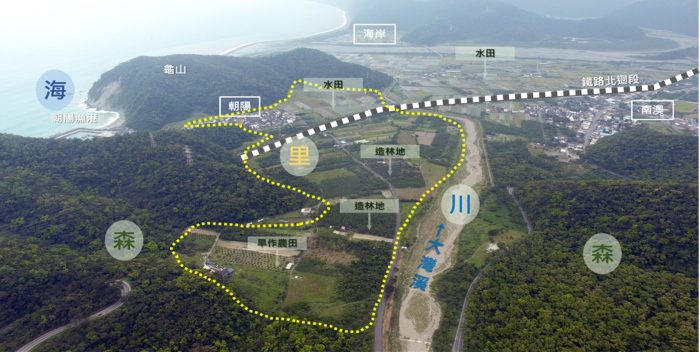
2. The Challenges Facing the Promotion of the Satoyama Initiative
(1) Limited Workforce Flexibility
Based on local interviews and observations, it’s evident that the community has access to multiple resources. Despite a relatively large number of hired staff within the association, the lack of community workers with the ability to coordinate, plan, and administer has led to a more conservative approach to development.
Given the aging population, the community development association primarily focuses on basic social welfare services such as communal meals for the elderly and maintaining environmental hygiene. The association’s financial resources rely heavily on social welfare and employment policy support, as well as revenue from the community-run restaurant, shops (Chaoyang Small Shop), and some tourism bookings.
With the workload already saturated by regular social welfare work and revenue-generating operations, developing new areas and tasks requires significant investment of time and effort, as well as additional personnel costs, which explains the conservative development approach.
(2) Inability to Leverage Chaoyang Harbor’s Coastal Resources
With limited manpower, the community, despite its proximity to Chaoyang Harbor and abundant coastal resources such as fishing and set net fishing, has been unable to deeply integrate these resources into local industrial development.
Unlike other Hakka communities in Taiwan that were established through maritime colonization, Chaoyang’s unique history has been limited to superficial explanations due to the community’s limited capacity.
Moreover, the traditional knowledge developed by the ancestors, who utilized local “satoyama” natural materials for making tools used in “satoumi” fishing, is gradually disappearing with modernization and cannot be preserved through community efforts.
(3) Urgent Need for a Remote Sales System
In recent years, the COVID-19 pandemic has had a profound impact on community enterprises. During the peak of the pandemic, community visits, tours, dining, and in-store sales were all affected. However, as the pandemic subsided, a surge in “revenge spending” led to a massive influx of tourists, making it difficult to maintain environmental and recreational quality.
The main reason for this is that most community enterprises are primarily brick-and-mortar businesses. For example, during the 2021 pandemic, with the surge in work-from-home and home cooking, the demand for online shopping increased significantly, but community enterprises failed to adapt to this trend.
Therefore, developing strategies to enhance the flexibility of community agricultural and specialty product sales through initiatives such as attracting physical visitors, promoting online shopping, and offering remote tours and product sales is a direction for future development.
3. Objectives and Strategies
The primary objective of the Satoumi Initiative in Chaoyang Community is to “conduct a Satoumi resources audit, develop secondary and tertiary industries, and drive the industrialization process to the six-sector industry.” Specifically, the initiative aims to:
(1) Partner with professional teams, supported by the county agricultural department’s comprehensive rural development plan, to assist the Chaoyang Community in clarifying its human resource allocation and securing external resources, ensuring a smooth transition to subsequent development stages.
(2) Conduct a comprehensive audit of fishery resources from coastal fishing and fixed net fishing grounds in Chaoyang Harbor. This includes assessing seasonal catches, resource characteristics, and potential for sustainable utilization. Additionally, explore opportunities to process the catch or integrate it into eco-tourism initiatives.
(3) Develop processed products from Satoumi resources and strengthen online sales platform and exposure to mitigate economic disruptions caused by factors such as epidemics, transportation inconveniences, and adverse weather conditions that may reduce on-site foot traffic.
(4) Develop community-based eco-tourism itineraries that combine local characteristics with suitable primary industries, test potential secondary processing industries, and integrate surrounding trails and local relationships.
Implement a six-sector industrialization process, develop feedback and environmental monitoring mechanisms, and invest in surrounding ecological conservation and related work.
4. Key Stakeholders and Their Roles
(1) Yilan County Government
The Yilan County Government plays a pivotal role in the development of Chaoyang Community. As the local governing body, the county government oversees various aspects of regional policies, including social, economic, and safety matters. Its departments are directly involved in the implementation of these policies.
(2) Chaoyang Community Development Association
Established under the Community Development Framework Act, the Chaoyang Community Development Association is a legally recognized entity that has successfully obtained funding from the Rural Regeneration Program. With a staff of four full-time employees and three additional positions supported by the Multiple Employment Development Program, the association also employs over ten people to operate its own restaurant and shops. This demonstrates a proactive approach in leveraging available resources. By introducing an external advisory team to work alongside the existing staff and realign responsibilities, the association can better address new tasks and projects.
(3) Cha Tzu Tang (茶籽堂)
Cha Tzu Tang, a social enterprise specializing in camellia oil and related food, skincare, and cleaning products, has been cultivating camellia trees in Chaoyang Community since 2016. Over the years, the company has established a Nanao office to support the community’s revitalization efforts. Cha Tzu Tang is also planning to build a camellia processing plant in Chaoyang, providing local farmers with contract farming opportunities and employment. In addition to economic development, the company is committed to promoting local culture, industry, and community development.
(4) Agency of Rural Development & Soil and Water Conservation, MOA (Headquarter and Taipei Branch, hereinafter referred to as the ARDSWC)
In recent years, the Ministry of Agriculture has been actively promoting the Satoyama Initiative. Given Chaoyang Community’s unique landscape and spatial scale, which encompasses elements of the Satoyama concept (forest, rivers, fields, and seas), and its residents’ long-standing tradition of sustainable resource utilization, the community is well-suited for overall development planning based on this initiative. Although the community has faced challenges in applying for Rural Regeneration Program grants due to limited manpower and resources, with appropriate external assistance or support from the Yilan County Government’s Bureau of Agriculture through its Comprehensive Rural Development Program, the community’s development can be significantly improved. The Taipei Branch of the Agency has been actively involved in improving the surrounding environment of Chaoyang Community, particularly in revitalizing the Chaoyang Fishing Port area to increase public access.
(5) Forestry and Nature Conservation Agency, MOA, Yilan Branch Office (hereinafter referred to as the FANCA)
Chaoyang Community is located at the southern end of the Chaoyang Trail, a national forest trail managed by the FANCA. This geographic advantage makes the community a key hub for hikers. The Chaoyang Community Development Association has been receiving funding from the FANCA’s Community Forestry Program to conduct regional natural resource audit, promote environmental education, conduct environmental patrols, and provide training for ecotourism. However, current efforts have primarily focused on forest and river resources, with limited exploration of marine resources.
5. Process of Implementation
(1) Phase 1 (2022-2023)
In recent years, the ARDSWC has conducted resilience assessment workshops in Chaoyang Community, familiarizing community leaders with resilience assessment procedures. Subsequently, the Yilan County Government organized a series of “Chaoyang Forest-River-Field-Sea Consensus Meetings” in the community. These meetings utilized the resilience assessment indicators as a starting point to discuss the community’s current situation and identify key issues and tasks related to promoting the Satoyama Initiative.
The assessment revealed that although the community is located near the ocean, due to social and economic changes, there are no longer any secondary industries
related to fishing. Moreover, younger generations have become increasingly distant and less knowledgeable about marine resources and the environment. To deepen the local connection with the ocean, the community has initiated an audit of coastal resources.
(2) Phase 2 (2023)
An assessment was conducted on the fishery resources caught through coastal fishing and set net fishing in Chaoyang Fishing Port to understand seasonal fishery products and resource characteristics. The goal was to identify sustainable marine resources suitable for utilization in different seasons and to explore suitable concepts for processed fishery products or eco-tourism, serving as a foundation for future promotion.
From March 30 to November 28, 2023, a total of 35 fishery catch surveys were completed at the fishing port. The records included 153 species of bony fish, 5 species of cartilaginous fish, 8 species of shrimp, 2 species of crab, and 3 species of cephalopod. The top 20 fish species with the highest recorded quantities, along with their corresponding fishing methods and sustainable seafood consumption recommendations, are presented in the following figure.
Based on the survey results, the following trends in fishery catches at Chaoyang Fishing Port were identified: (1) The majority of species with the largest biomass were pelagic migratory schooling fish; (2) Different fishing methods resulted in different fish species being caught; (3) Reef areas yielded a higher diversity of fish species but lower biomass; and (4) Set nets primarily caught fish species recommended for consumption.
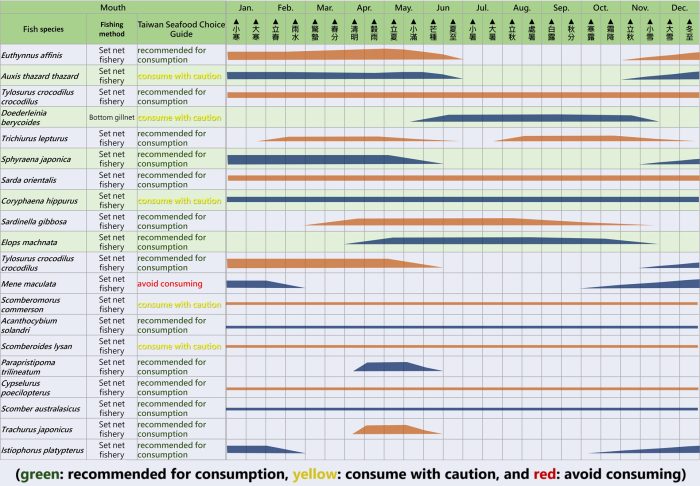
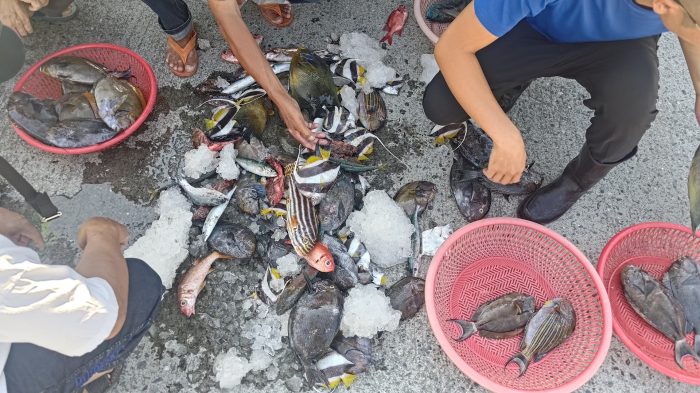

The community-run seafood restaurant has been gradually increasing its procurement of “recommended” sustainable seafood species and, whenever possible, sourcing seafood caught using methods that have a lower environmental impact, such as single-hook fishing and set net fishing. The restaurant also incorporates the concept of sustainable seafood choices into its menu descriptions for customers.
During the COVID-19 pandemic, when travel restrictions reduced tourism in the Chaoyang community, the community’s existing industries and products lacked remote consumption capabilities. In response, the community conducted a feasibility study on processing local seafood and developed processed seafood products.
Among the fish species caught in large quantities at Chaoyang Fishing Port, the Striped bonito (Sarda orientalis) was identified as an excellent candidate for processing due to its delicious flavor, regional uniqueness, sustainability, and strong connection to local culture. After discussions with the community, a production process for bonito fish floss was developed and implemented locally.
This approach reduced raw material logistics costs, allowed for small-scale production to maintain product quality, and provided employment opportunities for local seniors. Additionally, it was recommended to use bonito caught after spawning in the spring as the raw material for fish floss, creating a sustainable and seasonal product.
Based on a comparison of similar products and cost calculations, the price of bonito fish floss was set between NT$1,250 and NT$1,500 per kilogram, demonstrating certain market competitiveness. The community shops now regularly produce and sell pastries and cakes containing bonito fish floss on weekends. These unique and story-rich products have attracted significant attention and encouraged tourists to visit the community, leading to increased sales of other local agricultural products.
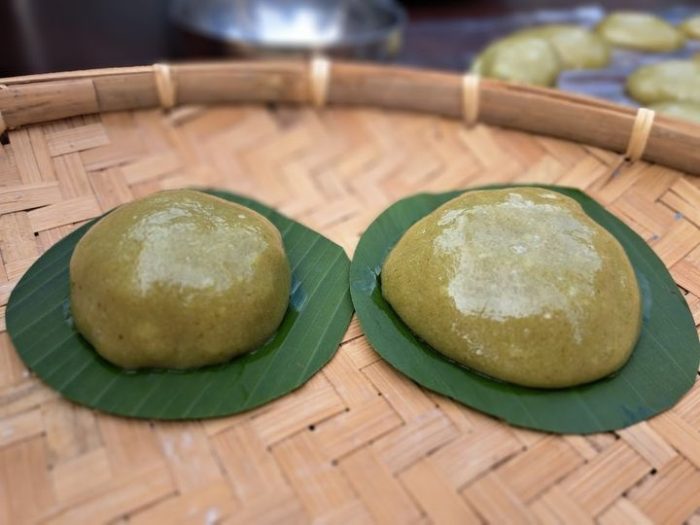

(3) Phase 3 (2024)
In line with the Satoumi Initiative, we will create new tour modules to be incorporated into the community’s ecotourism offerings. These 30-minute modules will combine local environmental interpretation with hands-on experiences in agriculture and handicrafts. By combining these modules, we can develop engaging half-day and full-day tours that promote sustainable tourism.
|
Tour Module Titles |
Tour Design Concepts and Content |
|
Chaoyang Satoumi Exploration |
Maintaining Chaoyang’s Coastal Landscape |
|
100 Ways to Fish |
Friendly Fishing Forum |
|
The Journey of the Striped Bonito |
Sustainable Seafood Choices: A Guided Tour |
5. Evaluation and Findings
(1) Alignment with the Kunming-Montreal Global Biodiversity Framework
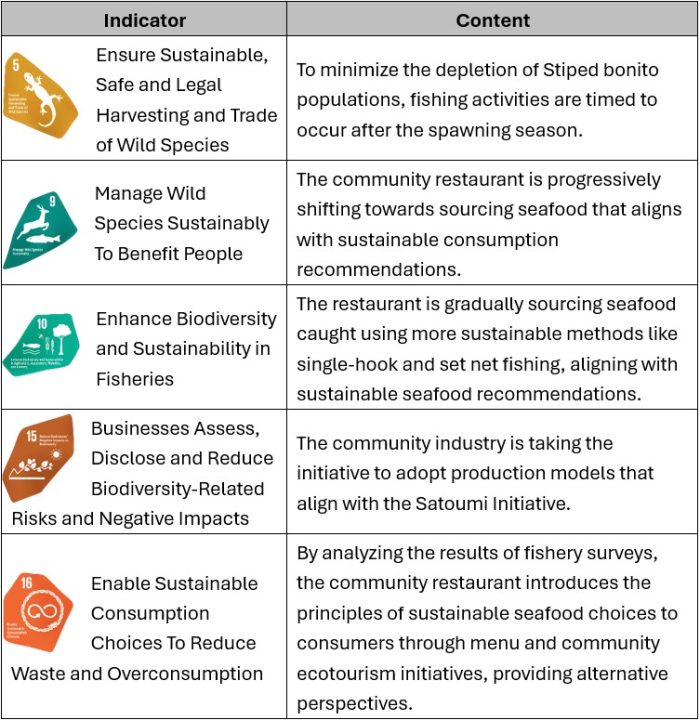
(2) Contributions to the United Nations Sustainable Development Goals (SDGs)
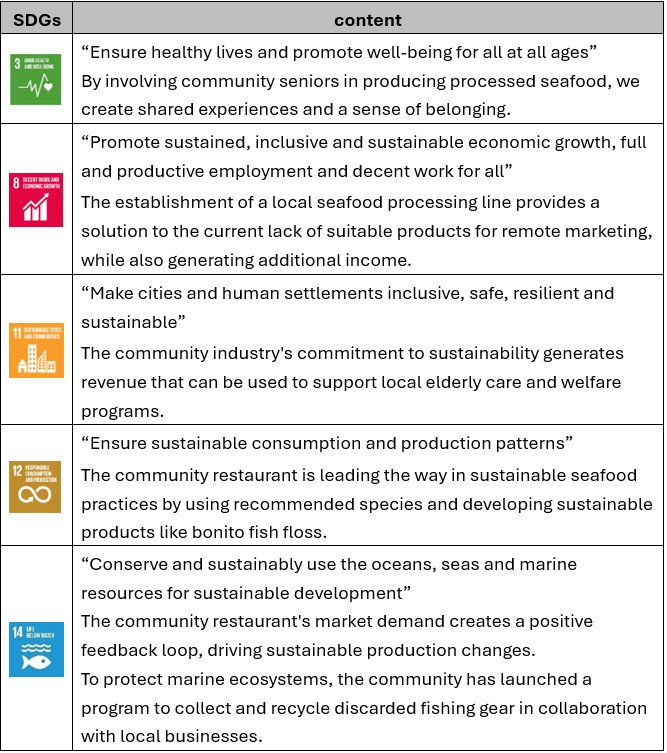
(3) Achievements and Innovations
- By integrating data from the completed Chaoyang Fishery database into seafood procurement and menu descriptions, the community restaurant is enhancing dining experiences and driving positive changes in local fishing practices.
- The development of bonito fish floss, a product combining sustainability, local flavors, and cultural heritage, sets a unique standard in Taiwan’s seafood industry.
- Chaoyang Community’s commitment to the Satoumi Initiative was recognized at the 2024 Taiwan National Gold Medal Village Competition, where the community’s achievements earned them the top prize.
(4) Challenges
The initial phase of this project focuses on influencing fishing practices in Chaoyang Harbor through market-based approaches and stakeholder engagement. While these efforts are promising, significant challenges remain, including the need for technological upgrades and policy support. The ultimate goal is to achieve a complete transition to sustainable net fishing, but this will require a concerted effort from all stakeholders.
(5) Long-Term Sustainability of Case Management
The integration of fishery data analysis into community-based businesses has fostered a sustainable economic model that aligns with our commitment to ocean conservation. Profits generated from these ventures are reinvested to support local communities, including job creation and social services.
7. Lesson Learned
The Chaoyang community faces challenges in implementing environmental initiatives due to staffing and financial constraints. By focusing on practical solutions, such as improving the community restaurant and developing locally sourced seafood products, the community has been able to balance environmental goals with economic needs, ensuring a higher level of community acceptance.

